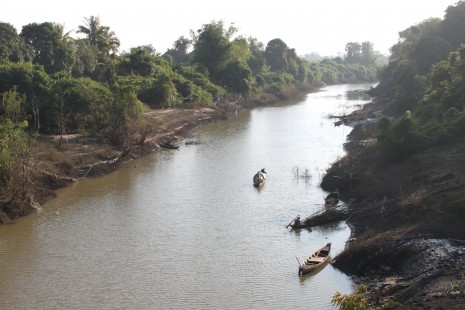Chet Borei district, Kratie province – Sitting at his outpost overlooking the Mekong River, Deab Kuy remembers an incident some years ago when fishermen threatened to attack him if they were stopped from casting their nets around the river’s sandy islets here in Sambok commune.

The outpost, little more than a wooden house on the banks of the Mekong, is one of 15 set up in Kratie and Stung Treng provinces where a total of 77 unarmed “river guards” monitor local fishing communities in an effort to protect the area’s endangered freshwater dolphins.
“When we went down to stop the fishermen, some of them would carry axes and machetes and hurl insults at us,” recounted Mr. Kuy, 32, one of three locals in Kampi village paid by the government to patrol the waters here.
“They never actually attacked us, but we felt very afraid,” he said.
While few can argue that saving the Mekong Dolphin is a noble cause, local fishermen say the conservation program is pushing them into poverty, and river guards say they are bearing the brunt of local resentment.
The post in Kampi, where there are an estimated 50 Mekong Dolphins, has at least three guards on duty every day. Since December, they have begun night patrols to stop villagers from fishing under the cover of darkness.
“On the water, it is usually calm and we can negotiate with each other and understand each other,” said Mr. Kuy. “But when we get back onto land, the people dislike us. Sometimes, if we want to buy fish from the market, they won’t sell it to us.”
Exact numbers of the remaining dolphins left in the Mekong around Kratie and Stung Treng are unclear.
Touch Seang Tana, chairman of the government’s Commission for the Mekong River Dolphin Conservation and Ecotourism Development, estimates there are 180 dolphins. The World Wildlife Fund puts the figure at about 80.
In September, the government approved a sub-decree demarcating a 180-km-long conservation area stretching from Kratie province to the Lao border. Gillnets, fishing cages and equipment used to electrocute fish is strictly banned in the protection zone.
Gillnets in particular are threatening the lives of the dolphins because their large mesh is left to drift in the river over night and can entangle large species like dolphins. On October 15, locals discovered a dead dolphin entwined inside a gillnet outside the conservation area, said Mr. Seang Tana. In total, gillnets have been responsible for the deaths of at least six dolphins so far this year.
Muong Ke, 41, a local fisherman, said he is unable to fish on the Mekong because of the unwanted attention he receives from the guards. Now, he must travel to a small pond where his catch has reduced dramatically.
“Before there [were] the [conservation] zones and the patrols, we would use many different types of nets and we can catch 10 kg of fish a day,” Mr. Ke said as he mended his fishing net. “Currently, we can catch only about 4 to 5 kg of fish a day.”
Before the ban in 2006, Mr. Ke caught fish by using electrocution methods and large gillnets. Today, he uses a traditional fishing net and hook-line.
“When they started patrolling, we continued fishing and the guards would confiscate the nets. I was very angry but I have no power to stop it. We just suffer from it,” he said.
His brother, Muong Sokleang, 52, said he is having an easier time taking tourists out on a boat to observe the dolphins for about 10,000 to 20,000 riel a day, or about $2.50 to $5 a day. He does some fishing on the side, but his catch has fallen from 10 kg before the ban to less than 1 kg today.
He admits, however, that not everyone can switch from fishing to tourism because most families do not have a boat.
In Thma Kre commune, 42-year-old Yun Ly Veng, chief of the commune’s river guards’ post, said he is still struggling to get the locals to understand why he has to confiscate their equipment. Going to the local market to buy food is always a challenge, he said, as the vendors sometimes gang up against him and there has been violence.
But Mr. Ly Veng believes that saving the dolphins can lead to the area’s development in the long run in terms of tourism.
“There is not much benefit to the fishermen [in protecting the dolphins] but it is our job to do this and it is good for the country,” he said.
According to the Ministry of Tourism, more than 17,000 international tourists visited Kratie in 2011, a 26 percent rise compared to the previous year. The number of visitors has continued to climb this year, with almost 14,000 tourists recorded in the first nine months of 2012, a 10 percent increase from the same period in 2011.
Ouk Sreynith, 22, whose family used to fish for a living, said they are now able to earn a relatively good living—$300 to $600 a month—from selling souvenirs of carved wooden dolphins to visiting tourists.
“Before, most of us were fishermen but after they created the dolphin commission, we were encouraged to start selling souvenirs to try to attract the tourists,” Ms. Sreynith said. “It’s much better for me and my family now.”




